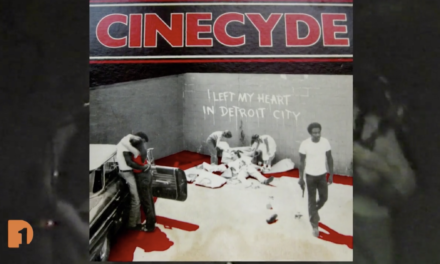Lake Huron and Lake Michigan come together in the Straits of Mackinac—long considered one of the most treacherous waterways on all of the Great Lakes. For nearly 150 years, the Spectacle Reef Lighthouse has guarded ships passing through the Straits. It sits twelve miles and a world away from the mainland. Today, the lighthouse needs restoration efforts if it’s going to survive.
RELATED: Lighthouse Restoration: A volunteer effort that requires labor, love and millions of dollars
Great Lakes Now talks with Pat McKinstry, president of the Spectacle Reef Preservation Society, and Carl and Marcia Jahn, two lighthouse keepers of the Great Lakes, about the Spectacle Reef Lighthouse, and the preservation efforts and initiatives going into restoring the historic, iconic site.
Full Transcripts:
Narrator: Lake Huron and Lake Michigan come together in the straits of Mackinac, long considered one of the most treacherous waterways on all of the Great Lakes. For nearly 150 years, the Spectacle Reef Lighthouse has guarded ships passing through the straits. It sits 12 miles and a world away from the mainland.
Patrick McKinstry, President, Spectacle Reef Preservation Society: You can see the strains of it all up there.
Narrator: Patrick McKinstry is the president of the Spectacle Reef Preservation Society, a nonprofit organization he and a group of lighthouse enthusiasts created to restore and preserve the light.
Patrick McKinstry: So, Northern Lake Huron Buoy has six-foot seas, strait Buckeye has 4, which means the light right now has four to five. The lighthouse was sold at auction in 2014 to a private individual who is a friend of mine, and he offered me the lighthouse. I wanted to buy the lighthouse for myself, but I believe that it should be in public hands because these were built with taxpayers’ dollars to save the lives of the public, and the people who lived there should be remembered as public servants. We put a team together of lighthouse historians, restoration enthusiasts, and the society raised the cash to purchase the lighthouse.
Narrator: When we caught up with him. Patrick and a group of volunteers were getting ready to take the 17-mile trek from Sheboygan to the lighthouse, hoping to make up some restoration work before the weather makes such trips too dangerous.
Patrick McKinstry: This crew is a very good crew and all of our volunteers are fantastic. We got 157 volunteers that joined the organization to save them, all their knowledge and skill sets, they all play a role. And what has impressed me is just the amount of passion that people have for this organization and saving his lighthouse.
Narrator: But working on a lighthouse that’s this far off the shore isn’t easy. The first challenge, just getting there.
Patrick McKinstry: My greatest fear is the same thing that the keepers’ experience, it’s the weather out here. There are days where you think it’s great and then the storm kicks up.
Narrator: And though the weather on this day looked pleasant enough, the threat of a sudden storm with high winds and heavy seas, forced the crew to return to the marina. The lighthouse would have to wait. Fortunately, by the next day, conditions had improved.
Patrick McKinstry: If you look down the water, you’ll see the reef plain as day.
Narrator: Spectacle Reef Lighthouse gets its name from the shallow reef it was built on. There are two shoals with a ridge between them that resemble a pair of eyeglasses. The design of the lighthouse makes it even stronger in severe weather.
Patrick McKinstry: The lighthouse is built out of giant limestone blocks that are 2 foot tall, and their width and the radius differs based on where they’re at in the light tower. But the way it’s built, they have these edges that are cut almost like puzzle pieces, so that when the waves hit the tower, it actually smashes it all together, making the joints stronger over time.
Narrator: Spectacle Reef was considered a technical marvel when it was built in 1869, and it became a model for lighthouses built throughout the Northern Great Lakes.
Patrick McKinstry: Technology and the base camp that was built for Spectacle on Government Island, built every other offshore lighthouse up in the straits Mackinac, particularly the Lake Huron side. But all the technology that was developed and engineered for Spectacle, makes her kind of the grandmother of every other offshore lighthouse on the Great Lakes land. We are on top of Spectacle Reef Lighthouse, about 97 feet above Lake Huron and the lower parapet, there’s two parapets, an upper and lower, we’re on the lower side right now.
The entire next level was just the lens, and the level below was the service room where they kept oil, wicks and material. Had their little office take care of their logs each night, you know, when the foghorn went off, that type of thing. So, when you’re out here at night, you’ll see this, I believe it’s 10 or 11 lighthouses fashioned out here at night. It gives it kind of a real idea why these are so important. You’re out in the middle of the lake, you know, and how the flash parents are all different, so people knew what they were looking at. Nowadays, it’s hard to tell because you got all these radio towers and whatnot, but when they were built, of course, it was pitch black out here and the only source of light you had was lighthouses.
Narrator: The goal of the Spectacle Reef Preservation Society is to create a learning light where people can come and experience the life of a lighthouse keeper and learn about the history of lighthouses on the Great Lakes.
Patrick McKinstry: This thing is kind of cool, it says, force speck, ortho tooth iodide, people back then would use this as some type of toothache medication. So in 64, a guy had a baby on shore and the waves sent him the footprints of their child, and so these footprints are still here. The engineering and the history there is important, but really it’s the stories of the people that were tough enough to survive working at a lighthouse 18 miles away from port, 12 miles in the middle lake, with no human contact for months on end, and some of whom gave up their lives to protect sailors out there. Those stories need to be preserved and told over and over again. And the lighthouse is the perfect conduit for that, since that is where they were based and that was their home for years on end.
Narrator: The first step of renovation was making the station safe for the people working on it. That meant filling holes in the floor and remediating lead paint. Next came structural repairs, waterproofing and other basic fixes. It all paves the way for the restoration and cosmetic work that will happen in the future.
Patrick McKinstry: This one is cracked. It’s another one up top that’s cracked, we’ll replace those today, too. We’ll put some plexiglass on this yellow. But these five over here say, excuse me, five, they were all shattered with holes in them and we replaced all those last week with brand new glass. So it’s floodproof, allegedly, it should take power from the waves and the wind pretty good. But we are in the land room of Spectacle Reef, this is our beautiful light that’s out here. It’s an LED light, it flashes red every five seconds, so one second on, four seconds off.
Narrator: The light is still maintained by the US Coast Guard and can be seen for 11 miles. But the fresnel lens that was in place when the lighthouse was automated in 1972 had a far greater reach.
Carl Jahn “Keeper Carl”, Lighthouse Keeper Re-enactor/ Member, Spectacle Reef Preservation Society: This piece comes to us from our light, Spectacle Read, this one piece of it and our lens had panels inside it that rotated around the eight-foot diameter light, that made it flash every four seconds.
Patrick McKinstry: The lens was a second over from now, and it had a red stroud attached to it on the outside. So as actually the heaviest fresnel lens ever used on the great leaves, and when it was installed, it could be seen for 29 miles.
Carl Jahn “Keeper Carl”: Just needs a lot of tender loving care.
Narrator: Carl Jahn is known as “Keeper Carl.” He’s a lighthouse keeper re-enactor and a member of the Spectacle Reef Preservation Society.
Carl Jahn “Keeper Carl”: Makes you look a little more official. It’s a love for lights, for whatever reason, that draws people like me and Patrick and everyone.
Patrick McKinstry: It’s my weirdness, right? If you put your ear up against it sometimes, it is almost like she kind of talks to you.
Carl Jahn “Keeper Carl”: We’ve got volunteers coming all the way from Texas, Wisconsin, families come over here to spend time to help us restore this light. Paint, scraping paint, sweeping floors, painting stuff, it’s enjoyable. Nobody comes out there and has to work six or eight hours that we can spend at the station. You’re there to have as much fun as you do and help us get the light preserved.
Mark Lee, Masonry Specialist: Out here at the Lighthouse, it’s pretty much whatever you can do to make it work and make everything stick.
Narrator: Mark Lee lives 20 miles across Lake Huron from the light and he can see it from his home. He’s a masonry specialist who does foundation repair and brickwork, and he’s a volunteer.
Mark Lee: Today, I patched a couple of holes that were pretty significant holes in the stairwell going up to the tower on the first floor. And then, I did a little bit of caulking and getting stuff ready for paint and making sure things are waterproof for the winter.
Narrator: The crew of volunteers had intended to stay and work until late in the day. But once again, the weather had other plans.
Carl Jahn “Keeper Carl”: We’ve got a storm coming in right now. We’re trying to beat it back to shore and we lock her up in a couple minutes, and we’re out of here.
Patrick McKinstry: Well, we got 20 minutes to leave before we may get caught in the weather. I’m still trying to get ahead of the weather. All right, guys, you guys might get wet on the way home, but I don’t want to repeat what we did 2 weeks ago, where we were out here in eight-foot seas for three hours because that was awful. Just offshore, at the 2nd most remote lighthouse on the Great Lakes and 3rd in the country, mother nature calls your shots.
Narrator: Patrick and his crew of volunteers will be back to continue their efforts to preserve the Spectacle Reef Lighthouse and to build a new generation of guardians of the Great Lakes.
Patrick McKinstry: What I want to achieve is to build that generation. So, when I can no longer walk and be in a wheelchair or whatever, you know, I can’t climb that ladder anymore, I know it’s in good hands. And she’ll still be there in great shape, teaching people the story and Spectacle Reef. Teaching people onshore some history, teaching techniques and methods on how to restore lighthouses. I can sit back in my retirement home and know she’s in good hands.
Stay Connected:
Subscribe to One Detroit’s YouTube Channel & Don’t miss One Detroit Mondays and Thursdays at 7:30 p.m. on Detroit Public TV, WTVS-Channel 56.
Catch the daily conversations on our website, Facebook, Twitter @DPTVOneDetroit, and Instagram @One.Detroit
View Past Episodes >
Watch One Detroit every Monday and Thursday at 7:30 p.m. ET on Detroit Public TV on Detroit Public TV, WTVS-Channel 56.




